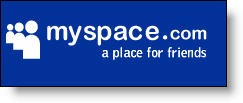 There are 63,198,783 members in MySpace as of 9:45 am Pacific Time today. Even if you subtract 25 million or so phony entries, you still have a vast audience, making it the fifth-most popular place online (trailing only Yahoo, Microsoft, Google, and eBay).
There are 63,198,783 members in MySpace as of 9:45 am Pacific Time today. Even if you subtract 25 million or so phony entries, you still have a vast audience, making it the fifth-most popular place online (trailing only Yahoo, Microsoft, Google, and eBay).
And it’s not all teenagers. According to the member search, there are 1,054 male and 634 female members aged 45 to 50 within five miles of my Seattle home. Of course, in the same vicinity there are 2,958 22-year-old males and more than 3,000 females of the same age (search results stop after 3,000 hits), so it definitely skews younger.
Financial institution opportunities
Forget about the over-30 crowd, you already understand what they need. But what about the younger group, the 21-and-over post-college crowd just starting jobs and beginning a 70+ year stretch of consuming financial services. What do they want in a bank?
Ultimately, they want what their parents want: safe storage of funds, convenient payment alternatives, access to substantial credit, and fair prices.
So far nothing new here. But how you attract these young consumers will be very different than how you acquired their parents. For example:
- Branches will have far less marketing impact: This is probably the biggest difference from past generations; that good-looking branch at the corner of First and Main will NOT automatically get you a 25% share of new hires in your neighborhood. Today’s new college grad is much more likely to do a Google search on "yourtown banks," check out your website, and if they like what they see, sign up for an account. Your branch network will only be an afterthought; nice to have, but not a key part of the decision.
- Website must be clean and fresh: Since your bank’s first impression will come from its online presence, you must keep investing to ensure a website, and features, that at least match the competition. You don’t let your landscaping go to seed in front of the branch, so why would you not tend your website in the same careful manner?
- Electronic communications channels: How does a 22-year old want to communicate with his/her bank? Think instant messaging from the PC, text messaging from the cell phone, and the ability to post questions for peer response. Email is also important for less timely information exchange, such as daily statement summaries and other account updates.
- Intuitive online products: Anyone under 25, who’s come of age in the Internet era, expects to handle routine matters online. From a bank, they expect simple and instant funds transfer and bill payment to anyone at any location, including account-to-account transfers. They want plastic for purchase (primarily debit) and a reasonable line of credit backing their checking account. They expect online archives measured in years, not months.
A note on pricing
Like their parents (and grandparents), they don’t expect to pay much, if anything, for these services. Free non-interest checking will continue to be required, but add-on fees for premium services should be acceptable. They will also be less price-sensitive for revolving credit, so position that 15% overdraft line of credit as a major part of the business case.
Advertising at MySpace
That brings us back to MySpace, a surprisingly non-commercial site at this time. But we expect that to change slowly over time as its owners, Rupert Murdoch’s News Corporation, which paid $580 million for the site last year, work on ways to make a return on that investment.
 The company is currently earning revenues from a single banner across most pages, a few smaller ads in certain areas such as Films, a large ad near the top of each member’s home page, plus Overture-served keyword ads for its site search and Web search (click on screenshot for a closeup of the search results page for the band "Green Day"). The site also has a classified section that looks a lot like Craigslist, but is sparsely used, at least in the Seattle area.
The company is currently earning revenues from a single banner across most pages, a few smaller ads in certain areas such as Films, a large ad near the top of each member’s home page, plus Overture-served keyword ads for its site search and Web search (click on screenshot for a closeup of the search results page for the band "Green Day"). The site also has a classified section that looks a lot like Craigslist, but is sparsely used, at least in the Seattle area.
For financial institutions, the main opportunity is traditional banner and display advertising. Today we saw banners from LendingTree, E*Trade and H&R Block (and AARP, was that a mistake?) But there is likely room for at least one or more financial institutions to strike deals with the company to become a preferred provider of banking services, with a premium position within the site, perhaps on the main navigation strip (think Amazon tabs), or in some yet-to-be-conceived commercial spot within the social networking site.
–JB